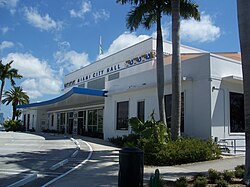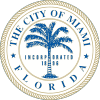Pan American Seaplane Base and Terminal Building | |
 Miami City Hall, former Pan American Terminal Building, in 2011 | |
| Location | 3500 Pan American Dr., Miami, Florida |
|---|---|
| Coordinates | 25°43′40″N80°14′02″W / 25.72773°N 80.2338°W |
| Area | 10 acres (4.0 ha) |
| Built | 1934 |
| NRHP reference No. | 75000548 [1] |
| Added to NRHP | February 20, 1975 |


Miami City Hall is the local government headquarters for the City of Miami, Florida. It has been located in the former Pan American Airlines Terminal Building on Dinner Key, which was designed by Delano & Aldrich and constructed in 1934 [2] for the former International Pan American Airport, [3] since 1954. [4] The city's government headquarters originated in Downtown Miami for 58 years until its relocation to Coconut Grove.







